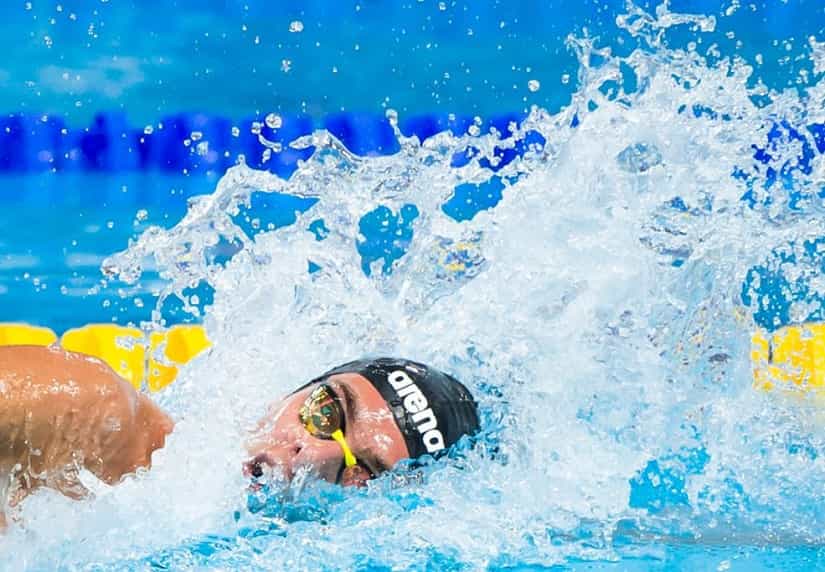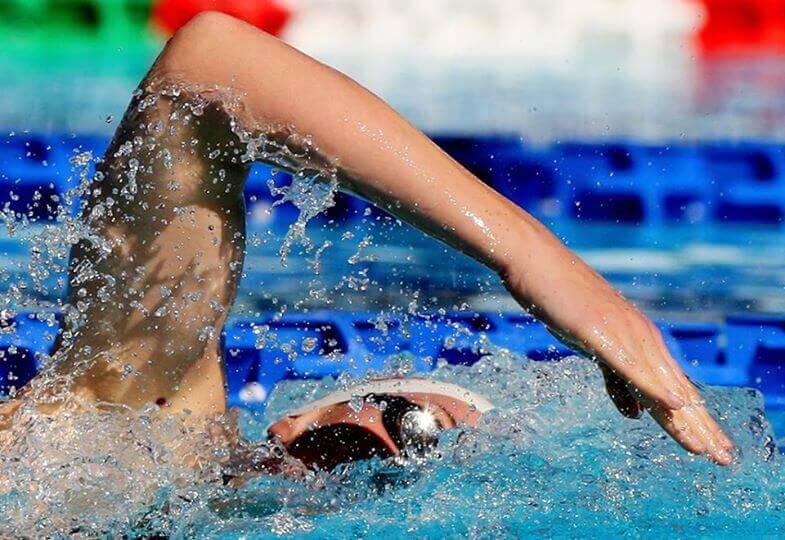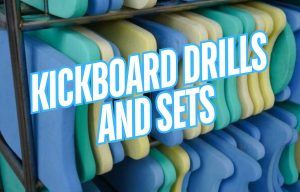
How to Use a Drag Chute for Faster Swimming
Looking for tips on how to use a drag chute for improved swim performances? Read on for some proven tips, sets, and pointers for training with a chute.

Ready to swim more efficient and faster freestyle? Power up your freestyle with ten freestyle drills from some of the best coaches and swimmers on the planet.
Everybody wants to swim faster freestyle and to improve their freestyle stroke, but all too often we get hung up on particular technical and mechanical shortcomings. Our catch isn’t strong enough, we lack proper rotation or our feel for the water isn’t quite there yet.
That’s where freestyle drills are designed to help, by getting you to focus on a particular segment of your stroke, and then transferring it to your regular swimming stroke.
The following swimming drills for freestyle are designed to help you swim faster and to swim better.
Drills shouldn’t just be done for the sake of doing them, but rather, to apply them to your swimming.
Pick and choose a couple of the drills to incorporate at your next swim workout, and mix it with your swimming in order to reap the benefits of developing a more purposeful and faster freestyle.

One of my favorite freestyle drills, and about as simple as it gets. Closed fist freestyle.
The drill is exactly as it sounds: You ball up your hands, removing the surface area that your out-stretched fingers would usually provide for your pull, and swim freestyle as you normally would.
It reinforces the notion that when you are pulling that you should also be using your forearms and not just your hands! This added emphasis on the surface area of the forearm also pushes you towards a higher elbow recovery.
Your stroke count per length will go down a little bit, and once you unclench those hands you will get a little jolt of power, your hands now feeling like over-sized swim paddles.
Best for: Increasing feel for the water with your forearm. Encouraging high elbow recovery.
This isn’t technically a drill, but it requires your full attention and concentration. The goal is simple: to swim as fast as you can, taking as few strokes as possible. Add time and stroke count together, and you get a total number that you should strive to beat.
This kind of swimming forces you to be efficient with every part of your stroke. You look for ways to take less stroke while maintaining speed, whether it’s keeping your hips raised, your head straight, nailing that high elbow recovery, and kicking without clanging your ankles together.
In the video below, while wearing fins and paddles, I am doing reps of 25-yards taking 5 strokes in approximately :10. (Giving me a Mini-Maxi score of 15.)
This is an advanced freestyle drill that helps you to really feel out every aspect of your stroke. In particular, the added resistance of the water to your recovery will help to strengthen and increase the arm speed on the recovery.
A problem many competitive swimmers have once they get to a particular level of conditioning is that their turnover is too slow. They have the distance per stroke aspect nailed down, but need to crank up the RPM.
This drill creates resistance on the arm recovery, which will have your arms flying once you return to regular freestyle.
Best for: Freestylers who want to improve hand speed in the water.
Not my favorite, but it does a couple of things for your swimming. It puts you off-balance, forcing you to kick harder to maintain a somewhat straight body line. It removes any over-glide at the front of your stroke because gliding will sink your face into the water.
I find that having your head up out of the water gives you another angle at your hand entry. The removal of the glide also forces you to maintain a continuous rhythm with your stroke, which will encourage a higher elbow recovery.
Perform the drill with fins for added leg work.
Best for: Freestylers who are prone to over-gliding. A good warm-up for sprint work later in the workout.
Another classic for hand speed and arm recovery speed for you freestylers with a classic, and one of my old stand-by drills– the hand-drag.
How do you do it? Swim freestyle normally, but during the recovery phase drag your hand through the water. Keep your hand rigid for added resistance (i.e. don’t just drag your hand limply through the water).
When you return to normal swimming your arm recovery will feel like it’s slashing through the air.
Take it to the next level by throwing on some paddles to make it even more challenging.
Best for: Improving hand speed, maintaining body line.
At the Sydney 2000 Olympics Michael Klim lead of the Australian men’s 4x100m freestyle relay. In the final 15m he switched his kick over to a dolphin kick (Klim is a multiple world record holder in the butterfly) as he powered into the wall, breaking the world record in the 100m freestyle with his hybrid stroke, clocking a 48.18.
It wasn’t until late 2015 that another elite swimmer–Michael Phelps–began also experimenting with fly kick at the end of freestyle races in international competition.
The reason that it works for these athletes is that they are both natural butterfliers, but also because the rhythm of using dolphin kicks helps to keep the stroke rate from tapering off when fatigue and exhaustion are setting in at the end of the race.
By adding dolphin kick to your freestyle arms you cannot help but begin to develop a rhythm that promotes the smooth, kayak stroke we want in our freestyle.
The first time trying it will be a little awkward, but once you get comfortable with it you’ll be surprised at how fast you can get going.
Best for: Improving stroke rhythm. Increasing stroke rate. Encouraging a high elbow catch.
Sculling is the Swiss-army knife of swimming drills. The variations you can come up with are nearly endless, and can help improve your feel for the water.
When you are doing sculling drills get your body positioned as closely as to when you are normally swimming to maximize effect. If this means using a pull-buoy or fins to achieve a proper body position, so be it!
Best for: Trouble-shooting the weak parts of your stroke.
I stumbled across this freestyle drill last year and fell in love with it right away. It comes courtesy of Mike Bottom (University of Michigan’s head coach), and one of his former swimmers Bobby Savulich who demonstrates it below.
I prefer doing it in a long course pool so that you can get a few stroke cycles in. With swimming fins on in particular once your arms get going you can build up some great speed.
Here is Coach Bottom explaining how the drill works:
Best for: Exploding the shoulders out of the water. Proper hand entry.
One of the classic freestyle drills, Catch-Up is used with swimmers from tadpoles to experienced Olympians.
Catch-up freestyle helps isolate arm movement, which is good for teaching young swimmers proper mechanics, helps with distance per stroke, while it also promotes a hand entry that doesn’t cross-over.
In the video below Lower Moreland Swimming’s head coach Karney McNear shows his swimmers performing the drill at a recent practice.
Notice how the drill encourages the swimmers to use a fuller and more balanced flutter kick in order to sustain propulsion:
Elite freestylers understand that having a strong early vertical forearm is essential to fast swimming. Having good EVF means that you get into the catch earlier, which results in a “fuller” and more powerful pulling motion.
Coley Stickels, coach at the University of Alabama, has used the retraction drill with his swimmers in the past, including Olympians Abbey Weitzel, Roland Schoeman and Santo Condorelli.
Some focus points on doing the drill properly:
Developing a smoother, more powerful freestyle is actually pretty simple when you start to break it down into sections.
Whether it is improving stroke rhythm, keeping your elbow from dropping, or increasing your stroke rate there is a drill to help you break it down and improve it.
Try out the above freestyle drills during your next practice and drill your way to a faster and more technically proficient freestyle.
** Shout-out to Coaches Brett Hawke, Karney McNear, and Coley Stickels for taking the time to share videos of the above drills.

Olivier Poirier-Leroy Olivier Poirier-Leroy is the founder of YourSwimLog.com. He is an author, former national level swimmer, two-time Olympic Trials qualifier, and swim coach.
✅ Free shipping on Orders over $49
✅ Price Match Guarantee
✅ Best selection of gear for training and competition
✅ Fast and Easy Returns

“This is the best book I have ever seen concerning mental training.” — Ray Benecki, Head Coach, The FISH Swim Team


Looking for tips on how to use a drag chute for improved swim performances? Read on for some proven tips, sets, and pointers for training with a chute.

Ready to take your swimming to the next level? Here are seven ways that a drag chute can help you become a better and faster swimmer.

Wondering if a swim bench can help improve your swimming? Here are six benefits of swim benches for better technique, more power, and faster swimming.

Not breathing into the walls is one of the fundamental skills developing swimmers are taught. Here is how powerful a no-breath approach is for turn and swim speed. Strong training habits are something swimmers hear a lot about from their earliest days of their competitive swimming careers. The greatest hits

Drills with a swim snorkel are one of the best ways to maximize engagement and skill development. Here are five swim snorkel drills to try for faster swimming.

Looking to add some flavor to your kick sets and workouts? Here are some kickboard drills swimmers can use for faster swimming.
SITE
SHOP
GUIDES

LANE 6 PUBLISHING LLC © 2012-2025
Join 33,000+ swimmers and swim coaches learning what it takes to swim faster.
Technique tips, training research, mental training skills, and lessons and advice from the best swimmers and coaches on the planet.
No Spam, Ever. Unsubscribe anytime.
